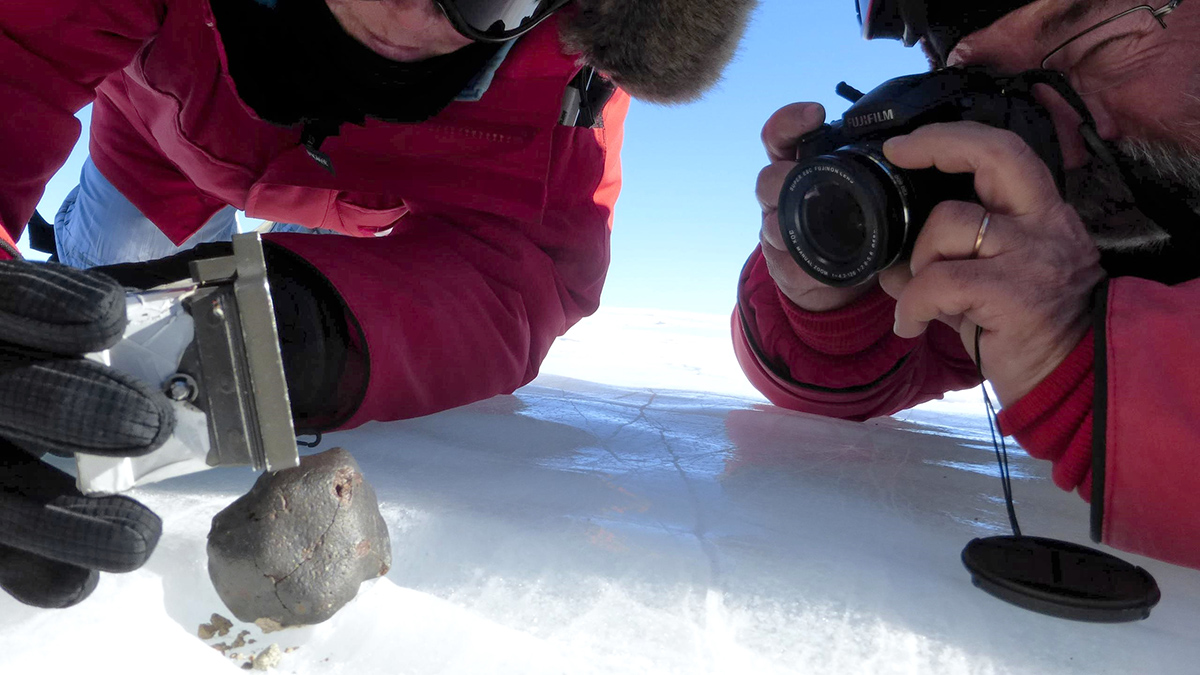For decades, scientists hunting for meteorites have known exactly where to go: the bottom of the world. Antarctica is a veritable treasure chest of space rocks, thanks to its shifting ice and relatively pristine surface. More than half the meteorites ever found have come from the frozen continent. But that may not hold for long.
A new study published in Nature Climate Change estimates that hundreds of thousands of meteorites could sink through the Antarctic ice and be out of reach by 2100 as the climate warms. Already, some 5,000 meteorites are likely being lost each year, the study authors estimate, a trend that could persist after 2050 should we fail to get global warming under control. Once in the ice, these meteorites are unlikely to ever be recovered.
“It’s not a future problem.”
“We estimate that the meteorites are being lost much quicker than we can find them at the moment,” said Veronica Tollenaar, a glaciologist and doctoral candidate at Université libre de Bruxelles and a coauthor on the paper.
She and her colleagues estimate that for every one tenth of a degree of warming, another 1%–2% of Antarctic meteorites will be lost.
It should be a wake-up call to scientists, especially their funders, they argue.
“It’s not a future problem,” said Harry Zekollari, a glaciologist at Vrije Universiteit Brussel and paper coauthor. “We need to act rapidly to save this unique archive.”
A Gold (or Rock) Mine for Meteorites
Antarctica is one of the most pristine places on Earth and sees very few of the natural processes such as rain, snowfall, and erosion that quickly bury or degrade meteorites that fall elsewhere. In rare patches of bare “blue ice” in Antarctica, thousands of meteorites have collected over thousands or even millions of years because of ice flows and are simply sitting on the ice, waiting to be picked up.
To date, around 50,000 meteorites have been gathered from Antarctica, representing around 60% of all meteorites ever found. The tally includes the first meteorite identified as coming from Mars, as well as the first lunar meteorites.
Scientists already knew that meteorites, which are dark, absorb far more radiation from the Sun than the ice they sit on. Even at temperatures well below freezing a meteorite can melt the ice beneath it and sink into a puddle of its own making, eventually becoming locked invisibly beneath the surface.
The magic temperature, the researchers found, is about −10°C (14°F).
“If temperatures go above this, even if it’s not often…you’re very unlikely to find meteorites,” Zekollari said.

The researchers started with a database of Antarctic meteorite locations Tollenaar built as part of her Ph.D. research. To create that data set, she used machine learning to combine estimates of ice flow speeds, snow levels, and temperatures and information on the ice surface to determine where meteorites are most likely to be found in Antarctica. For the more recent study, the researchers did much the same thing, this time using different temperatures drawn from climate simulations to simulate where meteorites might disappear in the future. The result considers how multiple variables interact, Tollenaar said.
“It’s not simply setting a [temperature] threshold,” she said. “It’s really integrating all the observations that we know are important.”
“It will be a significant loss if we’re not able to access many of these materials.”
The number of meteorites Antarctica stands to lose varies depending on how much global temperatures warm. Under current policies, which would create an estimated 2.7°C (4.8°F) of warming by 2100, 28%–30% of Antarctic meteorites could disappear. That number rises to 55% and 76% with 4°C and 6°C (7.2°F and 10.8°F) of warming, respectively. No matter the scenario, those numbers amount to hundreds of thousands of meteorites being lost.
“I don’t think that I realized or recognized just how significant it could be,” said Meenakshi Wadhwa, a planetary scientist at Arizona State University who wasn’t affiliated with the research. “It will be a significant loss if we’re not able to access many of these materials.”
Scientific Funders, Take Heed
In addition to being easy to find, most Antarctic meteorites are largely untouched by Earth’s environment thanks to the continent’s ice. That lack of contamination means these space rocks can give scientists far more information on planets and asteroids in the solar system than meteorites found elsewhere. Antarctic meteorites, though not easy to get to, are relatively cheap to acquire.
They’re “a poor person’s space probe,” Wadhwa said. Instead of sending a mission to space, “for a fraction of the cost, you can actually do a lot of science on these materials.”
Indeed, this research may matter more to funding agencies than scientists themselves, said Geoffrey Evatt, an applied mathematician who works with the United Kingdom’s Lost Meteorites of Antarctica project.
“It really helps answer a question and poses this challenge to funders,” Evatt said. “We globally need to work together and actually have a concerted effort to collect these meteorites before many, many of them sink into the ice.”
—Nathaniel Scharping (@nathanielscharp), Science Writer

Leave a Reply